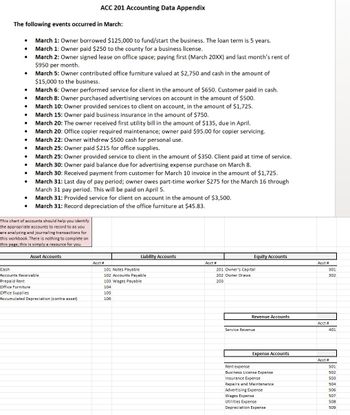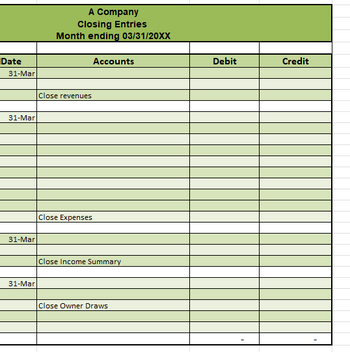
FINANCIAL ACCOUNTING
10th Edition
ISBN: 9781259964947
Author: Libby
Publisher: MCG
expand_more
expand_more
format_list_bulleted
Concept explainers
Question
Please don't provide answer in image format thank you
Hello. Can I get some assistance on what my closing entries should look like? I have included data that will help.

Transcribed Image Text:The following events occurred in March:
●
●
●
·
·
●
·
●
●
●
●
•
●
March 1: Owner borrowed $125,000 to fund/start the business. The loan term is 5 years.
March 1: Owner paid $250 to the county for a business license.
March 2: Owner signed lease on office space; paying first (March 20XX) and last month's rent of
$950 per month.
March 5: Owner contributed office furniture valued at $2,750 and cash in the amount of
$15,000 to the business.
March 6: Owner performed service for client in the amount of $650. Customer paid in cash.
March 8: Owner purchased advertising services on account in the amount of $500.
March 10: Owner provided services to client on account, in the amount of $1,725.
ACC 201 Accounting Data Appendix
March 15: Owner paid business insurance in the amount of $750.
March 20: The owner received first utility bill in the amount of $135, due in April.
March 20: Office copier required maintenance; owner paid $95.00 for copier servicing.
March 22: Owner withdrew $500 cash for personal use.
March 25: Owner paid $215 for office supplies.
March 25: Owner provided service to client in the amount of $350. Client paid at time of service.
March 30: Owner paid balance due for advertising expense purchase on March 8.
March 30: Received payment from customer for March 10 invoice in the amount of $1,725.
March 31: Last day of pay period; owner owes part-time worker $275 for the March 16 through
March 31 pay period. This will be paid on April 5.
March 31: Provided service for client on account in the amount of $3,500.
March 31: Record depreciation of the office furniture at $45.83.
This chart of accounts should help you identify
the appropriate accounts to record to as you
are analyzing and journaling transactions for
this workbook. There is nothing to complete on
this page; this is simply a resource for you.
Asset Accounts
Cash
Accounts Receivable
Prepaid Rent
Office Furniture
Office Supplies
Accumulated Depreciation (contra asset)
Acct #
Liability Accounts
101 Notes Payable
102 Accounts Payable
103 Wages Payable
104
105
106
Acct #
Equity Accounts
201 Owner's Capital
202 Owner Draws
203
Revenue Accounts
Service Revenue
Expense Accounts
Rent expense
Business License Expense
Insurance Expense
Repairs and Maintenance
Advertising Expense
Wages Expense
Utilities Expense
Depreciation Expense
Acct #
301
302
Acct #
401
Acct #
501
502
503
504
506
507
508
509

Transcribed Image Text:Date
31-Mar
31-Mar
31-Mar
31-Mar
A Company
Closing Entries
Month ending 03/31/20XX
Close revenues
Close Expenses
Accounts
Close Income Summary
Close Owner Draws
Debit
Credit
Expert Solution
This question has been solved!
Explore an expertly crafted, step-by-step solution for a thorough understanding of key concepts.
This is a popular solution
Trending nowThis is a popular solution!
Step by stepSolved in 4 steps

Knowledge Booster
Learn more about
Need a deep-dive on the concept behind this application? Look no further. Learn more about this topic, accounting and related others by exploring similar questions and additional content below.Similar questions
- How would I calculate this problem? I just guessed on which answer made sense to me. Please help. thank you in advance.arrow_forwardWhat is the easiest way to complete a closing entry. Are there any shortcuts or techniques that are useful to remember?arrow_forwardDescribe how to close entries properly.arrow_forward
- True or false? In a manual system, it is proper to splits journal entry at the bottom page.arrow_forwardhow do you do adjusting entries?arrow_forwardHow do you get a report into PDF format? Select an answer: You need to email the report and then convert it to PDF. Click on the Export button and Click on Export as PDF. You cannot export reports into PDF. You have to print the report and then scan it as a PDF.arrow_forward
arrow_back_ios
arrow_forward_ios
Recommended textbooks for you

 AccountingAccountingISBN:9781337272094Author:WARREN, Carl S., Reeve, James M., Duchac, Jonathan E.Publisher:Cengage Learning,
AccountingAccountingISBN:9781337272094Author:WARREN, Carl S., Reeve, James M., Duchac, Jonathan E.Publisher:Cengage Learning, Accounting Information SystemsAccountingISBN:9781337619202Author:Hall, James A.Publisher:Cengage Learning,
Accounting Information SystemsAccountingISBN:9781337619202Author:Hall, James A.Publisher:Cengage Learning, Horngren's Cost Accounting: A Managerial Emphasis...AccountingISBN:9780134475585Author:Srikant M. Datar, Madhav V. RajanPublisher:PEARSON
Horngren's Cost Accounting: A Managerial Emphasis...AccountingISBN:9780134475585Author:Srikant M. Datar, Madhav V. RajanPublisher:PEARSON Intermediate AccountingAccountingISBN:9781259722660Author:J. David Spiceland, Mark W. Nelson, Wayne M ThomasPublisher:McGraw-Hill Education
Intermediate AccountingAccountingISBN:9781259722660Author:J. David Spiceland, Mark W. Nelson, Wayne M ThomasPublisher:McGraw-Hill Education Financial and Managerial AccountingAccountingISBN:9781259726705Author:John J Wild, Ken W. Shaw, Barbara Chiappetta Fundamental Accounting PrinciplesPublisher:McGraw-Hill Education
Financial and Managerial AccountingAccountingISBN:9781259726705Author:John J Wild, Ken W. Shaw, Barbara Chiappetta Fundamental Accounting PrinciplesPublisher:McGraw-Hill Education


Accounting
Accounting
ISBN:9781337272094
Author:WARREN, Carl S., Reeve, James M., Duchac, Jonathan E.
Publisher:Cengage Learning,

Accounting Information Systems
Accounting
ISBN:9781337619202
Author:Hall, James A.
Publisher:Cengage Learning,

Horngren's Cost Accounting: A Managerial Emphasis...
Accounting
ISBN:9780134475585
Author:Srikant M. Datar, Madhav V. Rajan
Publisher:PEARSON

Intermediate Accounting
Accounting
ISBN:9781259722660
Author:J. David Spiceland, Mark W. Nelson, Wayne M Thomas
Publisher:McGraw-Hill Education

Financial and Managerial Accounting
Accounting
ISBN:9781259726705
Author:John J Wild, Ken W. Shaw, Barbara Chiappetta Fundamental Accounting Principles
Publisher:McGraw-Hill Education